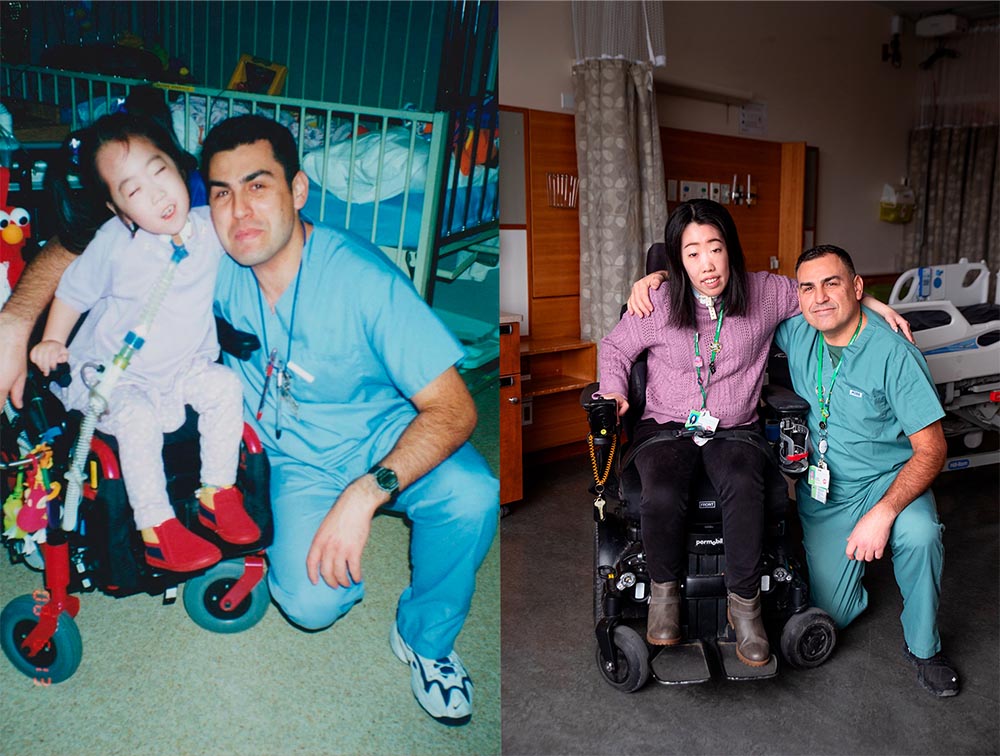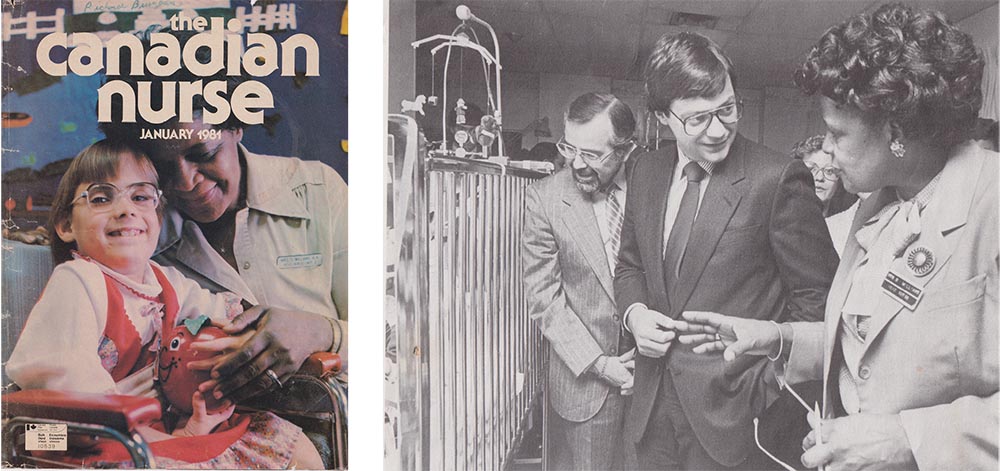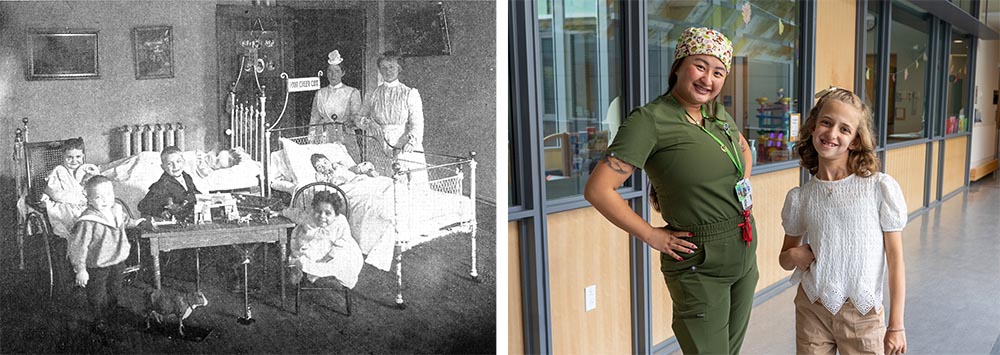
Evolution of pediatric rehabilitation

Evolution of pediatric rehabilitation
Click the button to hear an audio version of the panel.
Emily’s Story:
In 1997, Emily Chan was admitted to the Bloorview MacMillan Centre, just a few weeks shy of her first birthday. As a medically-complex infant with a neuromuscular condition, Emily spent nearly six years living at the hospital where she underwent intense inpatient rehabilitation, including help with muscle control, feeding, swallowing, bathing and dressing. As a toddler, she enjoyed racing her wheelchair through the halls with nurses chasing her. She especially enjoyed being chased by her favourite nurse, Jorge Santos, who still works at Holland Bloorview today. Initially, it seemed that Emily might live at the hospital for her entire life — but thanks to the hard work of Emily, her family and the hospital team all that changed. Gradually, through working with staff, her parents learned how to care for Emily at home, allowing her, at age six to be discharged from the hospital.
Emily describes Jorge and the staff who cared for her as her second set of parents and she still considers Holland Bloorview her home away from home. So it’s no surprise that today, after completing a masters in social work, that Emily now works as a social worker in the same complex care unit where she lived nearly 30 years earlier.

Left: Emily Chan and nurse Jorge Santos, 1997.
Right: Emily Chan, now a social worker at the hospital with nurse Jorge Santos, 2024.
So much has shifted in pediatric rehabilitation since Emily first came to Holland Bloorview over three decades ago. Doreth Williams, 95, and former head nurse on what was then known as “Unit C” at the Bloorview Children’s Hospital, reflects on some of the shifts she saw over the course of her career.
“I continue to believe that children with disabilities have so much to contribute to society […] It’s up to us to show resolve and interest in each and every child.” – Doreth Williams, Unit C head nurse from 1976-1988.
“[In those days] many children with disabilities were not always accepted in the community structure. In some cases parents had a difficult time bonding with their child,” recalls Williams. “That’s why we focused on caring for the physical needs of our patients, but also placed an equal amount of emphasis on their emotional needs. Something as simple as picking a child up after bathing them and saying ‘I love you’.”

Left: Doreth Williams and client on cover of Canadian Nurse magazine, January 1981.
Right: Doreth Williams meeting Health Minister Murray Elston during his visit to Bloorview in 1985.
Rehabilitation reimagined
Thanks to advances in medical care, technology and research, alongside equally significant attitudinal shifts in how society thinks about disability, pediatric rehabilitation has been reimagined since the “Home for Incurable Children” opened its doors in 1899 to “Rachel,” the hospital’s first patient.
Sadly, we know very little about Rachel other than her name and that she lived with liver cancer. Back then, children like Rachel would have spent their entire childhoods in the “Home,” attended to by a rotation of visiting volunteer physicians. For many years, the therapy department consisted of just a single occupational therapist. Discharge was a trying and difficult transition — most young people were transferred to the Adult Home for Incurables (later known as the Queen Elizabeth Hospital) upon their 18th birthday.
Today, remarkably, the average length of stay for inpatient clients at Holland Bloorview is less than 45 days and we serve nearly 500 inpatients each year with diagnoses ranging from acquired brain injury and spinal cord injury to cerebral palsy and cancer.
A pivotal moment in our organization’s history came in 1996 when Bloorview Children’s Hospital (an inpatient, long-term care facility) merged with the Hugh MacMillan Rehabilitation Centre (an ambulatory facility with a smaller inpatient rehabilitation unit) to form the Bloorview MacMillan Centre that operated at two separate sites under a unified name. Today Holland Bloorview is proud to welcome nearly 500 inpatient and 56,000 outpatient admissions, serving more than 9,500 clients and families annually.

Left: Photo of children living at the“Home for Incurable Children,” annual report, 1910.
Right: Photo of client and clincian in front of the inpatient therapeutic playroom, 2023.
The most meaningful and healthy futures
Over the decades, Holland Bloorview’s vision has also shifted and evolved to a broader belief in each client’s agency and independence, with a focus on transitions, inclusion and community. Across its many programs, the hospital does everything from connecting youth with disabilities to early volunteer and work opportunities, to information and support to transitioning and adult medical services and adult life. Today, clients and families work with a multidisciplinary team of clinicians, not just a singular visiting doctor or therapist, all focused on a singular goal of helping children and youth with disabilities realize the most meaningful and healthy futures.

But as Chan points out, there is still farther we can go together.
“Society has become a lot more inclusive and accessible – but we still have a long way to go. For example, there are still a lot of places I can’t go because they aren’t physically accessible. Advocacy efforts can’t just come from us [those individuals with disabilities]. As a community we need non-disabled partners, spokespersons and champions to join us. We can’t do it on our own. We need support.”
Share your experience at Holland Bloorview or your hope for the future of pediatric rehabilitation here.

Do you have a special memory from our Spiral Garden? We’d love for you to share it with us! Please post a photo or a brief recount of your experience here.
